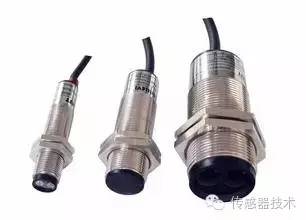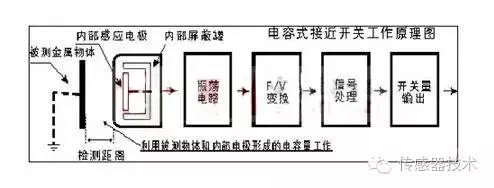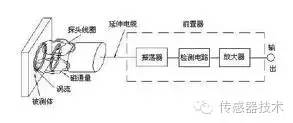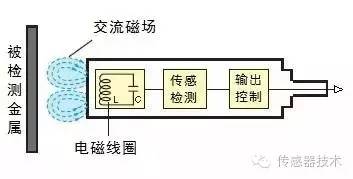Proximity sensors are widely used in various automated production lines, mechatronics equipment and various industries such as petroleum, chemical, military, scientific research, etc. What is proximity sensor?
Proximity sensorThe proximity sensor is a general term for a sensor that does not require contact with a detection object for detection, instead of a contact detection method such as a limit switch. It can convert the movement information and presence information of the detection object into electrical signals.
In the detection method for conversion to an electric signal, a method of detecting an eddy current generated in a metal body to be detected by electromagnetic induction, a method of changing a capacity of an electric signal caused by approaching a sample, and a method of guiding a switch and a guide switch are included. . It consists of an inductive type, an electrostatic capacity type, an ultrasonic type, a photoelectric type, and a magnetic type.

The proximity sensor is an alternating magnetic field generated by the vibrator. When the metal target approaches the magnetic field and reaches the sensing distance, eddy current occurs in the metal target, thus causing the vibration to attenuate, so that the vibrator close to the sensor stops. The vibration of the vibrator of the proximity sensor and the change of the vibration stop are processed by the post-amplifier circuit and converted into a switching signal, which triggers the drive control device, thereby achieving the purpose of non-contact detection of the proximity sensor. This is how the proximity sensor works.
Technical advantages1 Since it can be detected in a non-contact manner, it does not wear and damage the object to be detected.
2 Due to the use of the contactless output method, the life extension (except for the magnetic type) uses the semiconductor output, which has no effect on the life of the contact.
3 Unlike the light detection method, it is suitable for use in water and oil environments, and is almost unaffected by the stains, oil, and water of the object to be detected. In addition, it also includes Teflon shell type and good drug resistant products.
4 High-speed response compared to contact switches.
5 Can correspond to a wide range of temperatures.
6 Unaffected by the color of the detected object: The physical property change of the detected object is detected, so it is hardly affected by the surface color or the like.
7 Unlike the contact type, it is affected by the surrounding temperature, surrounding objects, and similar sensors, including the inductive type and the electrostatic capacity type. Therefore, for the setting of the sensor, mutual interference needs to be considered. In addition, in the inductive type, it is necessary to consider the influence of the surrounding metal, and in the electrostatic capacity type, the influence of the surrounding objects needs to be considered.
When the metal detector is close to the sensing area of ​​the sensor, the switch can be contactless, without pressure, without spark, and quickly issue electrical commands, accurately reflecting the position and stroke of the moving mechanism, even for general stroke control, its positioning accuracy, operating frequency The service life, the convenience of installation adjustment and the ability to adapt to harsh environments are all comparable to the general mechanical travel switch.
Proximity sensor classificationThe proximity sensor is divided according to the working principle:
High-frequency oscillation type, capacitance type, induction bridge type, permanent magnet type and Hall effect type.
According to the principle of operation, it can be divided into three categories:
The high-frequency oscillation type using electromagnetic induction uses a magnetic type of a magnet and a capacitance type using a capacitance change.
According to the detection method:
General purpose: mainly detecting ferrous metal (iron)
All metal types: detect any metal within the same detection distance.
Non-ferrous metal type: mainly for the detection of non-ferrous metals such as aluminum
According to the structure type:
1. Two-wire proximity sensor:
The two-wire proximity sensor is simple to install and convenient to wire; it is widely used, but has the disadvantages of large residual voltage and large leakage current.
2, DC three-wire type:
The output types of DC three-wire proximity sensors are NPN and PNP. In the 1970s, most of the Japanese products were NPN outputs, and NPN and PNP were available in Western European countries. The PNP output proximity sensor is generally applied to PLC or computer as a control command. The NPN output proximity sensor is used to control more DC relays. In practical applications, the output form should be selected according to the characteristics of the control circuit.
How different types of proximity sensors workCapacitive proximity sensor works: Capacitive proximity sensor consists of a high-frequency oscillator and an amplifier. A capacitor is formed between the detection surface of the sensor and the ground. It participates in the oscillation circuit and starts to oscillate. When the object approaches the sensor detection surface, the capacitance of the loop changes, causing the high frequency oscillator to oscillate. The two states of oscillation and stoppage are converted into electrical signals that are converted into binary switching signals by an amplifier.

The working principle of inductive proximity sensor: Inductive proximity sensor consists of high frequency oscillation, detection, amplification, trigger and output circuit. The oscillator generates an alternating electromagnetic field on the sensor detection surface. When the metal object approaches the sensor detection surface, the eddy current generated in the metal absorbs the energy of the oscillator, so that the oscillation is weakened and the vibration is stopped. The oscillation and oscillation of the oscillator are converted into electrical signals and converted into binary switching signals by shaping amplification, which are output after power amplification.

The working principle of the high-frequency oscillating proximity sensor: consists of an LC high-frequency oscillator and an amplifier processor circuit. When a metal object approaches the oscillating sensor head, eddy current is generated, so that the oscillation capability of the proximity sensor is attenuated, and the parameters of the internal circuit are changed. This identifies the presence or absence of a metal object, which in turn controls the on or off of the switch.

The working principle of all metal sensors: All metal sensors are basically high frequency oscillation type. Like the normal type, it also has an oscillating circuit in which the energy loss caused by the induced current flowing in the target affects the oscillation frequency. When the target approaches the sensor, the oscillation frequency increases regardless of the metal type of the target. The sensor detects this change and outputs a detection signal.
The working principle of the non-ferrous metal sensor: the non-ferrous metal sensor is basically a high-frequency oscillation type. It has an oscillating circuit in which the energy loss caused by the induced current flowing in the target affects the change of the oscillation frequency. When a non-ferrous metal object such as aluminum or copper approaches the sensor, the oscillation frequency increases; when a ferrous metal object such as iron approaches the sensor, the oscillation frequency decreases. If the oscillation frequency is higher than the reference frequency, the sensor outputs a signal.
The working principle of the universal proximity sensor: the coil L in the oscillating circuit generates a high frequency magnetic field. When the target is close to the magnetic field, an induced current (eddy current) is generated in the target due to electromagnetic induction. As the target approaches the sensor, the induced current increases, causing the load in the oscillating circuit to increase. Then, the oscillation is weakened until it stops. The sensor detects the change in the oscillation state by the amplitude detecting circuit and outputs a detection signal.
Proximity sensor selection and detectionProximity sensor selection:
For different material detectors and different detection distances, different types of proximity sensors should be used to make them have high performance-price ratio in the system. For this reason, the following principles should be followed in the selection:
1. When the test object is made of metal material: The high-frequency oscillation type proximity sensor should be used. This type of proximity sensor is the most sensitive to the detection of iron-nickel and A3 steel samples. For aluminum, brass and stainless steel samples, the detection sensitivity is low.

2. When the test object is a non-metallic material: Capacitive proximity sensors such as wood, paper, plastic, glass and water should be used.
3. For long-distance detection and control of metal and non-metal: Photoelectric proximity sensor or ultrasonic proximity sensor should be used.
4. When detecting body metal but the sensitivity is not high: use a low-cost magnetic proximity sensor or Hall-type proximity sensor.
Elements of proximity sensor selection:
1 Detection type: amplifier built-in type, amplifier separated type; 2 shape: round, square, groove type; 3 detection distance: in mm; 4 detection object: iron, steel, copper, aluminum, plastic, water, Paper, etc.; 5 working power: DC, AC, AC and DC universal; 6 Output form: normally open (NO), normally closed (NC); 7 output mode: two-wire, three-wire (NPN, PNP); 8 shielding, Unshielded; 9 wire lead-out type, connector type, connector relay type; 10 response frequency: several objects can be detected in one second
Proximity sensor detection:
Determination of the release distance: When the action piece leaves the sensing surface of the proximity sensor from the front side, and the switch is turned from the action to the release, the maximum distance of the action piece from the sensing surface is measured.
Measurement of the hysteresis H: the absolute value of the difference between the maximum operating distance and the releasing distance.
Action frequency measurement: drive the bakelite disc with a speed-regulating motor, fix a number of steel sheets on the disc, adjust the distance between the switch sensing surface and the action piece, about 80% of the switch action distance, rotate the disc, and then make the action The piece is close to the proximity sensor, and a speed measuring device is mounted on the spindle of the disk, and the switch output signal is shaped and connected to the digital frequency meter. At this time, the motor is started, and the rotation speed is gradually increased. Under the condition that the product of the rotation speed and the action piece is equal to the frequency count, the frequency of the switch can be directly read by the frequency meter.
Repeating accuracy measurement: The action piece is fixed on the measuring tool, and the moving speed is controlled at 0.1 mm/s from the action area of ​​the switch sensing surface facing the switch from the switch operating distance of 120%. When the switch is actuated, read the reading on the gauge and then exit the action zone to open the switch. This is repeated 10 times, and finally the difference between the maximum value and the minimum value of 10 measurements and the 10 times average value is calculated, and the difference is the repeat precision error.
Common troubleshooting for proximity sensors1 Stable power supply to the proximity sensor separately;
2 The response frequency is within the rated range;
3 There is jitter in the object detection process, resulting in exceeding the detection area;
4 multiple probes are tightly mounted to interfere with each other;
5 There are other objects in the test area around the sensor probe;
6 There are high-power devices around the proximity sensor and electrical interference.
Proximity sensors are widely used in machine tools, metallurgy, chemical, textile and printing industries. It can be used as a limit, counting, positioning control and automatic protection in the automatic control system. Proximity sensors have long service life, reliable operation, high repeatability, no mechanical wear, no spark, no noise, strong anti-vibration ability. At present, proximity sensors are becoming more widely used, and their own development and innovation speed is extremely rapid.
High definition LED displays or HD led screen also called Small pixel pitch led display screens represents the latest and
top technology of LED display industrial, they are widely used in high-end
conference
rooms, TV studios, the government mansion, etc. With 400mm*300mm cabinet
size, it is very easy to get 16:9 or 4:3 display ratio. As the 400*300mm cabinet is light weight and has high precision in cabinet size.
HD LED Video Wall ,HD LED Video Wall, indoor LED Display, Indoor LED screen
Shenzhen Priva Tech Co., Ltd. , https://www.privaled.com